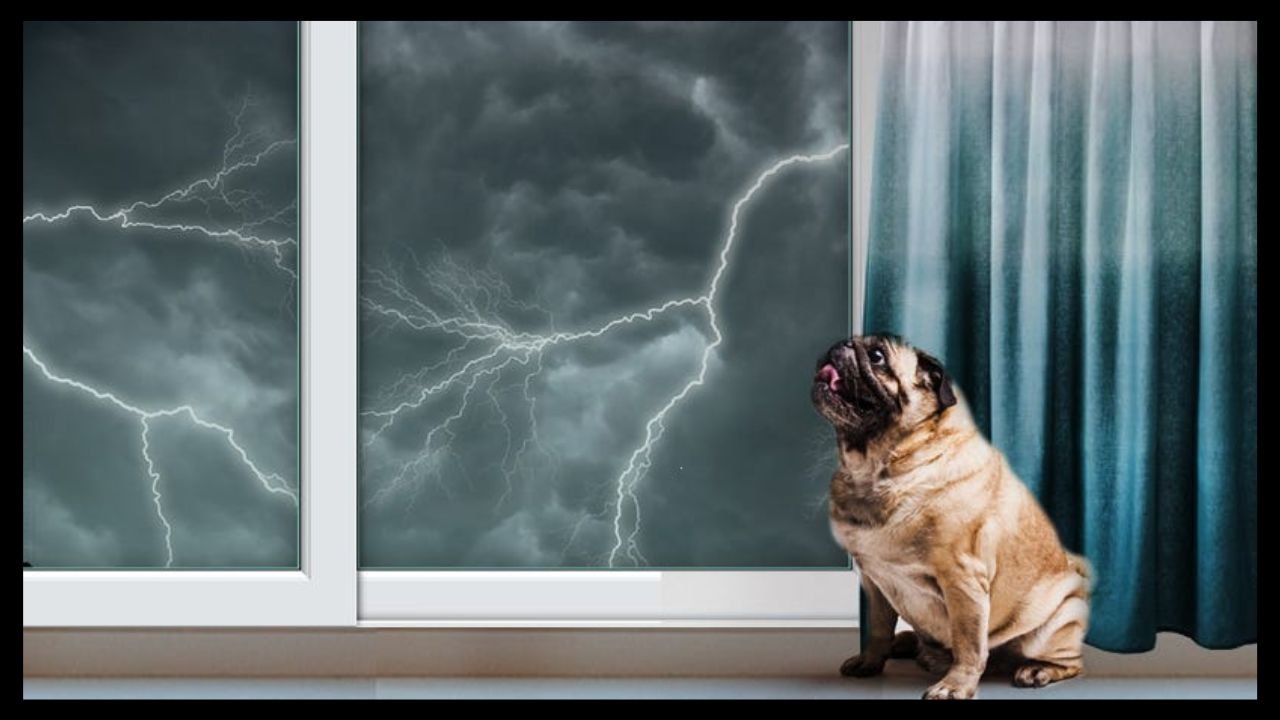Dogs are more than just pets—they’re family. But even our loyal companions can struggle during a storm. Loud thunderclaps, flashes of lightning, and sudden changes in weather can trigger anxiety or fear in dogs, often leading to destructive behavior. If you’ve been wondering how to protect walls from dog during storm, you’re not alone. Scratched, chewed, or damaged walls are common challenges pet owners face during stormy weather. But don’t worry—there are practical and effective solutions that can protect your home and provide comfort for your furry friend.
This guide covers everything you need to know, from understanding storm anxiety in dogs to implementing physical and behavioral remedies to safeguard your walls.
Understanding the Problem
Why Do Dogs React to Storms?
Dogs have heightened senses compared to humans, which makes them especially vulnerable to the sensory overload caused by storms. Here’s why your dog may act out during a storm:
- Fear of Loud Noises
The boom of thunder can be overwhelming and frightening. The lack of a discernible source for these noises compounds the stress.
- Sensitivity to Barometric Pressure
Changes in the weather, especially shifts in air pressure, are often sensed by dogs before a storm.
- Flashes of Lightning
The sudden, bright flashes can startle dogs and heighten their anxiety.
How Storm Anxiety Affects Your Home
An anxious dog may channel their stress into destructive behaviors like scratching or chewing. While furniture and doors often take the brunt, walls can also suffer significant damage. Dogs may dig at drywall near the baseboards or chew on edges, leaving visible scars.
Signs of Storm Anxiety in Dogs
Recognizing Common Signs
Before you can protect your home, it’s essential to understand whether your dog is experiencing storm anxiety. Signs include:
- Shaking or Trembling: A classic sign of fear.
- Panting or Drooling: Stress-induced symptoms that occur during storms.
- Hiding: Dogs may try to wedge themselves under beds, tables, or other tight spaces.
- Whining or Barking: Vocal dogs will communicate their anxiety through noise.
- Destructive Behavior: Scratching, chewing, or digging at walls or furniture.
Why Observe These Behaviors?
Knowing these signs allows you to implement preemptive measures. Understanding your dog’s unique responses is invaluable for customizing solutions to both protect your home and alleviate their distress.
Practical Steps to Protect Walls
Creating a Safe Space
Providing your dog with a comforting, secure space can reduce their urge to damage walls.
- Set Up a Calm Environment: Use their crate or a small room with limited distractions.
- Add Comfort Items: Include favorite blankets, toys, or chew items.
- Play Calming Music: Soundscapes or white noise can drown out storm sounds.
Behavioral Training
Long-term solutions often focus on understanding and modifying your dog’s behavior.
- Positive Reinforcement: Reward calm behavior to help them associate storms with positive outcomes.
- Desensitization Techniques: Gradually expose your dog to low-volume recordings of storm sounds, pairing them with treats or praise.
- Professional Training: Trainers can implement targeted programs for dogs with severe anxiety.
Physical Protection — How to Protect Walls from Dog During Storm
Sometimes preventative physical measures are necessary, especially for persistent chewers or scratchers.
- Wall Guards: Install plastic or metal panels along the lower sections of walls. These are easy to clean and protect surfaces from damage.
- Temporary Covers: Use furniture, cardboard, or removable wall panels to shield specific areas your dog frequently targets.
- Special Coatings: Apply pet-safe sprays with unpleasant tastes to deter chewing.
Advanced Solutions for Severe Cases
Consultation with a Veterinarian
For dogs with extreme anxiety, professional advice is vital.
- Anxiety Medications: A vet may prescribe short-term sedatives or long-term anti-anxiety medications.
- Supplementary Aids: Natural remedies like CBD oil or pheromone diffusers can also ease stress.
Calming Aids
- ThunderShirts: These are snug vests designed to provide a comforting “hug” effect.
- Chewable Supplements: Many are specially formulated with ingredients like L-theanine to promote relaxation.
Long-Term Strategies for Home Protection
Building Resilience in Your Dog
Over time, you can desensitize your dog to storms, ensuring they cause less distress.
- Counter-Conditioning: Pair storms or storm-like sounds with highly desirable treats to change how your dog perceives these events.
- Routine Building: Dogs thrive on predictability. Maintaining a consistent schedule can reduce storm-time anxiety.
Regular Home Maintenance and Inspection
After addressing your dog’s anxiety, inspect your home for any damage from previous storms.
- Repaint scratched or damaged walls.
- Reapply pet-safe protective coatings as needed.
Thoughtful Home Design for Pet Owners
Consider designing your home with pet-friendly materials that offer durability and ease of cleaning, such as washable paints or metal trims in high-traffic areas.
Safeguard Your Home and Comfort Your Dog
Protecting walls from dog anxiety during storms requires a mix of understanding, preparation, and proactive solutions. By creating a safe environment and incorporating training or physical barriers, pet owners can safeguard their homes while prioritizing their dog’s well-being. Severe cases can benefit from consulting a veterinarian or an animal behaviorist for guidance.
You May Also Like: Autobà Moths A Deep-Dive into Francis Walker’s Discovery
Conclusion
Protecting your walls from your dog during storms involves a combination of preparation, training, and the use of protective materials. Dogs often exhibit anxious behavior during storms, such as scratching or chewing walls, due to fear. Addressing this requires understanding and managing their anxiety while safeguarding your home.
Key strategies include creating a safe space for your dog, using calming techniques like white noise or anxiety wraps, and applying temporary wall protectors such as furniture shields or scratch-resistant panels. Training your dog to manage stress and providing distractions like toys or treats can also reduce destructive behaviors.
In summary, protecting walls during storms involves a holistic approach: ensuring your dog feels safe, minimizing stress triggers, and using physical barriers to shield your walls. This approach not only preserves your home but also supports your dog’s emotional well-being.
FAQs
How does storm anxiety in dogs lead to wall damage?
Dogs experiencing storm anxiety often channel this stress into behaviors like scratching or chewing, which can damage walls or other parts of your home.
What materials are best for temporary wall protection?
Plastic wall panels, durable furniture barriers, or even corrugated cardboard can effectively safeguard your walls during storms.
Can thunder shirts help reduce destructive behaviors in dogs?
Yes, ThunderShirts or similar compression garments can help ease a dog’s storm anxiety, indirectly reducing tendencies toward destructive behavior.
How do you calm a highly anxious dog?
Try creating a safe space with their favorite blankets and toys, use calming music, and consider natural supplements or vet-prescribed medications.
Is there a way to prevent storm anxiety altogether?
While you may not entirely eliminate storm anxiety, training techniques like desensitization and counter-conditioning can help your dog handle storms better over time.











